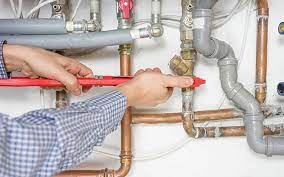Many homeowners need to understand how their plumbing systems work. This ignorance can result in issues that could be prevented by being familiar with the fundamentals of house plumbing.
The main components of a plumbing system are freshwater supply pipes and wastewater removal pipes.
Water Supply Pipes
A plumbing system is a network of pipes that bring fresh water into a house, carry waste water away, and connect fixtures. Most homes have two central systems: the water supply line and the drain-waste-vent system.
The water supply line routes municipal or healthy water from the street into your home through a meter and a water heater, then to faucets, showers, toilets, sinks, and appliances like dishwashers and washing machines. It’s usually made of plastic, iron, or copper pipe. The flexible plastic tubing called PEX is famous for water supply lines because it’s affordable and more accessible to install than rigid metal pipes.
Your house also needs a venting system to keep sewer gas and other toxic gases from entering the living spaces. The venting pipes travel through the roof and out into the air, preventing dangerous and smelly gases from seeping into your home.
Water Heaters
Your home’s water heaters provide hot water for dishwashers, clothes, showers, and tubs. These gadgets use an internal gas burner or electric heating element to warm the cold incoming water. After the water is heated, it is stored within the tank until you turn on a faucet that requires hot water.
The water enters your water heater via a dip tube connecting to the tank’s base. The hot water supply valve allows the warm water to exit your water heater when needed. A pressure relief valve also prevents excessive water pressure from damaging your pipes. Plumbers Longmont are trained to repair, replace, or install these units.
Drainage Pipes
A plumbing system’s drain lines carry used water away. Without this, your home could flood, or the sewage could go back into your fixtures and make you sick.
Fresh, clean water enters the house via supply pipes and travels under pressure to each fixture. A meter registers how much water you use, and the main shut-off valve is usually close by.
The drainage system funnels wastewater (sometimes referred to as foul drainage or wastewater) from your showers, bathtubs, sinks, toilets, and other water-using appliances into drain lines that lead to the sewer line. Each drain pipe is downward angled to help it flow easily. Drain pipes also contain traps to prevent clogs. They’re usually made of copper, polyvinyl chloride (PVC), or acrylonitrile butadiene styrene (ABS).
Faucets
The water supply system provides a steady flow of fresh, clean water to sinks and other fixtures. This includes toilets, faucets, bathtubs, showers, and appliances like washing machines and dishwashers.
The drain waste system takes wastewater and sewage away from your home. It includes drainpipes and vent pipes that carry wastewater to the sewer line, which has it to your municipal treatment plant or septic tank.
The faucets in your home provide hot and cold water for kitchens, bathrooms, and other spaces. Faucets include shut-off valves so that you can control the flow of water. Most are made of brass, an alloy of copper and zinc that resists corrosion from hard water. They come in various finishes that hold up to wear and tear, including chrome, which is easy to clean.
Toilets
Toilets are one of the most critical components in a plumbing system. They send unwanted wastewater into drainage pipes, which are carried to the sewer or septic tank. In developed countries, effective sanitation systems prevent fecal waste from polluting waterways and groundwater supplies.
The toilet may be seated or squat-style and can be designed to use a cistern. A simple flush valve is connected directly to the water supply in the latter case.
Modern toilets are often tank-type and use 1.28 gallons per flush or less, a huge savings over older, higher-flow models that predate federal restrictions. These newer low-flow toilets can reduce household water consumption by 20% to 60%, saving you a substantial amount of money over the lifetime of the toilets.
